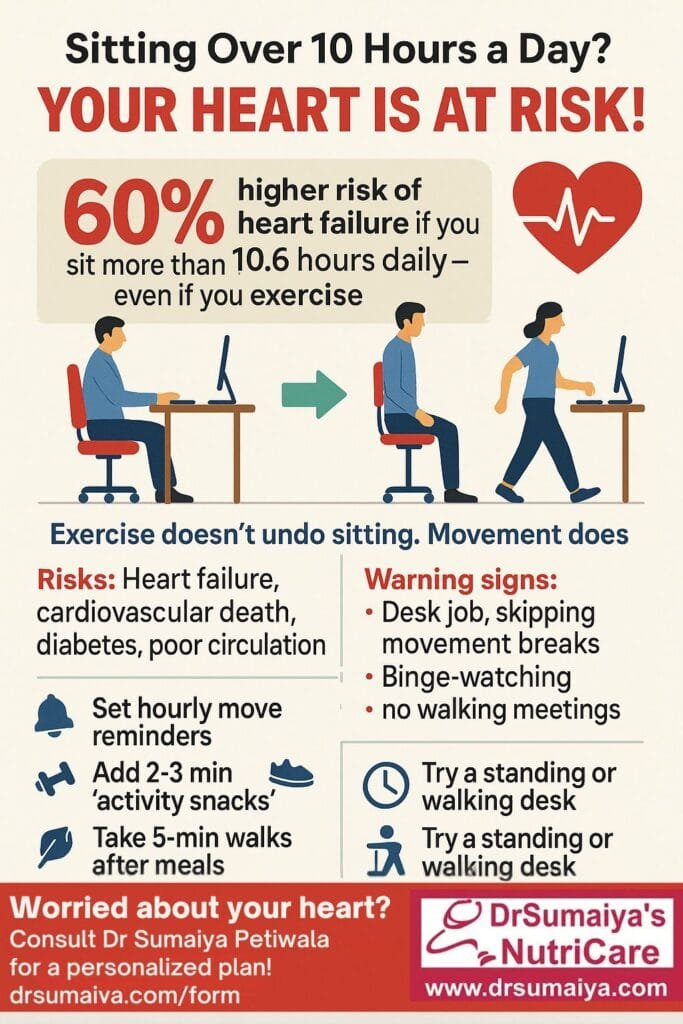Recent research from the UK Biobank has revealed a concerning connection between extended sitting time and heart health that affects even those who exercise regularly. Sedentary behavior exceeding 10.6 hours daily significantly increases cardiovascular risks despite maintaining recommended physical activity levels. This comprehensive guide explores how prolonged sitting affects your heart, why exercise alone isn’t enough, and practical strategies to incorporate more movement throughout your day to protect your cardiovascular health.
Table of Contents
- The UK Biobank Study: Key Findings
- Why Exercise Doesn’t Cancel Out Prolonged Sitting
- Are You at Risk? Warning Signs
- The Science Behind Sedentary Behavior
- 5 Practical Strategies to Reduce Sitting Time
- Beyond Standing: Why Movement Matters
- Special Considerations for Desk Workers
- Conclusion
The UK Biobank Study: Key Findings
The groundbreaking research analyzed data from 89,530 participants who wore activity trackers for one week, with follow-up over eight years. The results were alarming for anyone who spends extended periods sitting1. Researchers found that individuals who sat for more than 10.6 hours daily faced a 40-60% higher risk of heart failure and cardiovascular death compared to those with less sedentary time13.
After the follow-up period, approximately 4.9% of participants developed atrial fibrillation, 2.1% developed heart failure, 1.84% experienced myocardial infarction, and 0.94% died from cardiovascular causes6. These statistics highlight the significant impact of sedentary behavior on heart health across various cardiovascular conditions.

Breaking Down the Numbers
The research clearly demonstrates that exceeding 10.6 hours of daily sitting time represents a critical threshold for cardiovascular risk2. Even more concerning, this increased risk persisted regardless of whether participants met the recommended 150 minutes of moderate-to-vigorous physical activity per week3. This challenges the common belief that a daily workout can offset the negative effects of prolonged sitting.
Why Exercise Doesn’t Cancel Out Prolonged Sitting
Many people assume that regular exercise provides a “free pass” to sit for the remainder of the day. However, the research tells a different story2. Even individuals who maintain an active lifestyle face elevated cardiovascular risks if they sit excessively throughout the day.
“Sedentary risk remained even in people who were physically active, which is important because many of us sit a lot and think that if we can get out at the end of the day and do some exercise we can counterbalance it,” explains lead researcher Ezimamaka Ajufo, a cardiology fellow at Brigham and Women’s Hospital1.
The Physiological Impact
When we sit for extended periods, several negative physiological changes occur:
- Reduced muscle activity leads to decreased metabolism
- Blood circulation slows, particularly in the lower extremities
- Energy expenditure decreases significantly
- Metabolic processes that regulate blood sugar, blood pressure, and fat breakdown become impaired24
Over time, these changes contribute to increased cardiovascular risk factors, including hypertension, hypercholesterolemia, and type 2 diabetes5. The muscles maintain their tone and function when standing, walking, or in an erect position, but sitting relaxes these muscles, and prolonged sitting leads to reduced metabolism and muscle wastage2.
Concerned about your sitting habits? Schedule a personalized consultation with Dr. Sumaiya for tailored advice!Are You at Risk? Warning Signs
You may be putting your heart at risk if your daily routine includes:
High-Risk Daily Patterns
- Desk job requiring 8+ hours of continuous sitting
- Limited or no movement breaks throughout the workday
- Extended screen time after work (binge-watching or scrolling)
- No utilization of walking meetings or standing desks
- Post-meal sedentary behavior rather than light activity23
These patterns are particularly concerning because they can lead to accumulated sedentary time well beyond the 10.6-hour threshold associated with significantly increased cardiovascular risk1. Even more concerning, these behaviors have become normalized in modern work environments, creating a silent epidemic of sedentary-related health issues.
The Science Behind Sedentary Behavior
Research shows distinct patterns in how sedentary behavior affects different cardiovascular outcomes. A comprehensive study from the UK Biobank found that for every 10 beats per minute increase in resting heart rate (often associated with poor fitness and sedentary behavior), there was a 22% greater hazard of all-cause mortality and a 17% greater hazard of cardiovascular mortality in men7.
For women, the corresponding figures were 19% greater hazard of all-cause mortality and 14% greater hazard of cardiovascular mortality7. These associations were more pronounced at younger than older ages, suggesting that addressing sedentary behavior earlier in life may have greater preventive benefits.
Gender Differences in Sedentary Risk
Interestingly, the associations between sedentary behavior and ischemic outcomes were stronger among men than women, but both sexes showed similar magnitudes of association for non-cardiovascular cancer mortality7. This suggests potential gender-specific mechanisms by which sedentary behavior affects health outcomes.
5 Practical Strategies to Reduce Sitting Time
Implementing these evidence-based strategies can help you reduce your daily sitting time and protect your cardiovascular health:
1. Set Hourly Movement Reminders
Configure your smartphone, smartwatch, or computer to alert you every hour to take a movement break. Even brief interruptions to sitting time can help mitigate some of the negative physiological effects of prolonged sitting13. These reminders serve as critical pattern interrupters in environments where sitting is the default behavior.
2. Incorporate “Activity Snacks”
These 2-3 minute movement breaks throughout your day can significantly reduce total sedentary time. Options include:
- Taking a brief walk around your office or home
- Climbing a flight of stairs
- Performing simple stretches at your desk
- Doing 10-15 bodyweight squats or desk push-ups12
Activity snacks require minimal time commitment but offer substantial cardiovascular benefits when practiced consistently throughout the day.
3. Implement Post-Meal Movement
Avoid sitting immediately after meals. Instead, take a short 5-minute walk to help regulate blood sugar levels and improve digestion23. This practice is particularly beneficial after lunch when many people experience an afternoon energy slump that might otherwise lead to extended sitting.
4. Track and Limit Daily Sitting Time
Begin monitoring your sitting time with the goal of keeping it under 10 hours daily. Smartphone apps, fitness trackers, and smartwatches can help quantify your sedentary behavior13. This awareness is often the first step toward meaningful behavioral change.
5. Consider Workplace Modifications
If possible, utilize a standing desk or request workplace accommodations that allow for postural variety throughout the day8. However, remember that standing alone isn’t sufficient – movement is key. A height-adjustable desk that allows for transitions between sitting and standing is ideal for most people.
Need personalized guidance on improving your movement habits? Consult with Dr. Sumaiya for expert recommendations!Beyond Standing: Why Movement Matters
While standing desks have gained popularity as an alternative to sitting, research suggests that standing alone may not provide significant cardiovascular benefits8. A study from the University of Sydney found that standing time beyond 2 hours per day was not associated with reduced risk of major cardiovascular disease and may even increase the risk of orthostatic circulatory problems like varicose veins and chronic venous insufficiency8.
The Movement Imperative
The key insight from recent research is that active movement, rather than simply not sitting, is what improves cardiovascular health. As researcher Matthew Ahmadi explains: “In order to improve cardiovascular health, you have to engage the cardiovascular system”8.
Effective approaches include:
- Walking meetings instead of seated conferences
- Regular transitions between sitting and standing
- Light activity breaks that elevate heart rate slightly
- Active commuting when possible
- Intentional movement during typically sedentary activities (like standing and stretching during television commercials)38
Special Considerations for Desk Workers
Office workers face unique challenges in reducing sedentary time. A typical 8-hour workday, combined with commuting and evening relaxation, can easily exceed the 10.6-hour threshold for increased cardiovascular risk1. However, several workplace-specific strategies can help:
Creating a Movement-Friendly Workspace
- Position frequently used items just out of reach to necessitate standing
- Schedule walking meetings for appropriate discussions
- Use a smaller water bottle that requires more frequent refills
- Set up workstation ergonomics to encourage postural changes
- Consider under-desk pedal exercisers or treadmill desks for active sitting23
Organizational Approaches
Forward-thinking organizations are implementing policies that encourage movement, such as:
- Structured movement breaks during meetings exceeding 60 minutes
- Workplace wellness programs that incentivize reduced sitting time
- Office designs that place printers, restrooms, and break rooms at distances requiring walking
- Cultural norms that make standing or moving during meetings acceptable3
These approaches recognize that individual behavior change is more successful when supported by environmental and policy modifications.
Conclusion
The evidence is clear: sitting for more than 10.6 hours daily significantly increases your risk of heart failure and cardiovascular death, even if you exercise regularly123. This finding challenges the common misconception that fitness activities can fully compensate for extended periods of sedentary behavior.
The key takeaway is that movement throughout the day, not just scheduled exercise, is essential for cardiovascular health. By implementing strategic “activity snacks,” tracking sitting time, creating movement-friendly environments, and being mindful of post-meal activity, you can significantly reduce your cardiovascular risk.
Remember that small changes, consistently applied, can have profound health benefits. Start today by identifying your highest-risk sedentary periods and implementing just one strategy to increase movement during that time.
Ready to transform your daily habits for better heart health? Book your consultation with Dr. Sumaiya today!How many hours do you sit each day? Share in the comments below and join our community discussion on strategies to move more throughout the day!
#heartHealth #sedentaryLifestyle #cardiovascularRisk #movementMatters #deskWorkout #preventiveHealth
Citations:
- https://news.harvard.edu/gazette/story/2024/11/study-finds-too-much-sitting-hurts-the-heart/
- https://indianexpress.com/article/health-wellness/sitting-for-10-plus-hours-in-a-day-why-even-exercise-wont-work-for-your-heart-health-9682733/
- https://www.medicaleconomics.com/view/your-short-trip-to-the-gym-doesn-t-cancel-out-your-long-day-of-sitting
- https://www.ijcmaas.com/images/archieve/IJCMAAS_MAY_2018_VOL18_ISS3_02PDF.pdf
- https://pmc.ncbi.nlm.nih.gov/articles/PMC7092398/
- https://www.acc.org/Latest-in-Cardiology/Articles/2024/11/13/21/17/sat-sitting-aha-2024
- https://journals.plos.org/plosone/article?id=10.1371%2Fjournal.pone.0233898
- https://www.tctmd.com/news/standing-alone-will-not-offset-sittings-cvd-risks-study-suggests
- https://pmc.ncbi.nlm.nih.gov/articles/PMC5997501/
- https://academic.oup.com/eurheartj/article/40/14/1158/3836952
- https://pmc.ncbi.nlm.nih.gov/articles/PMC3913650/
- https://www.sciencedirect.com/science/article/abs/pii/S0167527324013093
- https://www.medscape.com/viewarticle/sitting-more-than-10-hours-daily-ups-heart-disease-risk-2024a1000l55
- https://www.hopkinsmedicine.org/health/wellness-and-prevention/why-exercise-isnt-enough-to-keep-your-heart-healthy
- https://pubmed.ncbi.nlm.nih.gov/15044412/
- https://www.ukbiobank.ac.uk/explore-your-participation/following-your-health/the-latest-heart-research-using-uk-biobank-data
- https://www.medicalnewstoday.com/articles/sitting-more-than-10-hours-day-may-increase-heart-failure-death-risk
- https://www.heart.org/en/news/2023/05/23/sitting-too-much-may-raise-heart-disease-risk
- https://www.thelancet.com/journals/lansea/article/PIIS2772-3682(23)00016-1/fulltext

